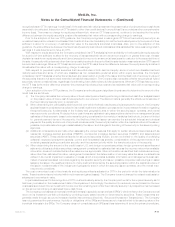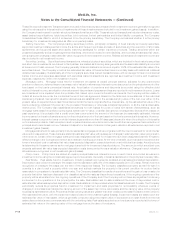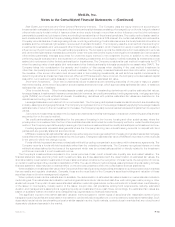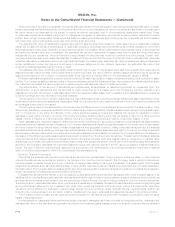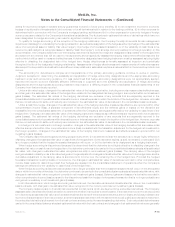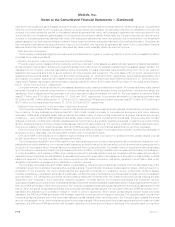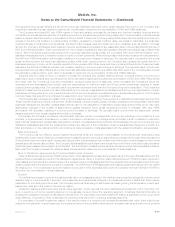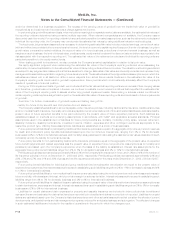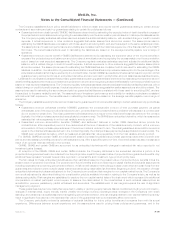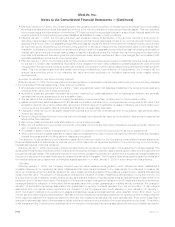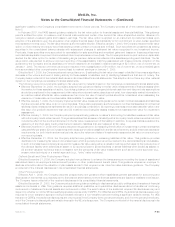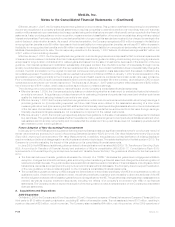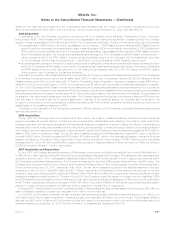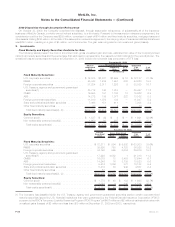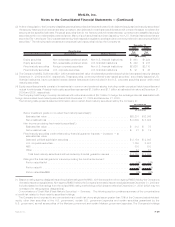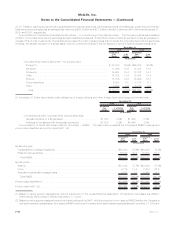MetLife 2009 Annual Report Download - page 105
Download and view the complete annual report
Please find page 105 of the 2009 MetLife annual report below. You can navigate through the pages in the report by either clicking on the pages listed below, or by using the keyword search tool below to find specific information within the annual report.determining whether valuation allowances should be established, as well as the amount of such allowances. When making such deter-
mination, consideration is given to, among other things, the following:
(i) future taxable income exclusive of reversing temporary differences and carryforwards;
(ii) future reversals of existing taxable temporary differences;
(iii) taxable income in prior carryback years; and
(iv) tax planning strategies.
The Company may be required to change its provision for income taxes in certain circumstances. Examples of such circumstances
include when the ultimate deductibility of certain items is challenged by taxing authorities (See also Note 15) or when estimates used in
determining valuation allowances on deferred tax assets significantly change or when receipt of new information indicates the need for
adjustment in valuation allowances. Additionally, future events, such as changes in tax laws, tax regulations, or interpretations of such laws or
regulations, could have an impact on the provision for income tax and the effective tax rate. Any such changes could significantly affect the
amounts reported in the consolidated financial statements in the year these changes occur.
The Company determines whether it is more-likely-than-not that a tax position will be sustained upon examination by the appropriate
taxingauthoritiesbeforeanypartofthebenefitcanberecordedinthefinancial statements. A tax position is measured at the largest amount of
benefit that is greater than 50 percent likely of being realized upon settlement. Unrecognized tax benefits due to tax uncertainties that do not
meet the threshold are included within other liabilities and are charged to earnings in the period that such determination is made.
The Company classifies interest recognized as interest expense and penalties recognized as a component of income tax.
Reinsurance
The Company enters into reinsurance agreements primarily as a purchaser of reinsurance for its various insurance products and also as a
provider of reinsurance for some insurance products issued by third parties.
For each of its reinsurance agreements, the Company determines if the agreement provides indemnification against loss or liability relating
to insurance risk in accordance with applicable accounting standards. The Company reviews all contractual features, particularly those that
may limit the amount of insurance risk to which the reinsurer is subject or features that delay the timely reimbursement of claims.
For reinsurance of existing in-force blocks of long-duration contracts that transfer significant insurance risk, the difference, if any, between
the amounts paid (received), and the liabilities ceded (assumed) related to the underlying contracts is considered the net cost of reinsurance
at the inception of the reinsurance agreement. The net cost of reinsurance is recorded as an adjustment to DAC and recognized as a
component of other expenses on a basis consistent with the way the acquisition costs on the underlying reinsured contracts would be
recognized. Subsequent amounts paid (received) on the reinsurance of in-force blocks, as well as amounts paid (received) related to new
business, are recorded as ceded (assumed) premiums and ceded (assumed) future policy benefit liabilities are established.
For prospective reinsurance of short-duration contracts that meet the criteria for reinsurance accounting, amounts paid (received) are
recorded as ceded (assumed) premiums and ceded (assumed) unearned premiums and are reflected as a component of premiums and other
receivables (future policy benefits). Such amounts are amortized through earned premiums over the remaining contract period in proportion
to the amount of protection provided. For retroactive reinsurance of short-duration contracts that meet the criteria of reinsurance accounting,
amounts paid (received) in excess of (which do not exceed) the related insurance liabilities ceded (assumed) are recognized immediately as a
loss. Any gains on such retroactive agreements are deferred and recorded in other liabilities. The gains are amortized primarily using the
recovery method.
The assumptions used to account for both long and short-duration reinsurance agreements are consistent with those used for the
underlying contracts. Ceded policyholder and contract related liabilities, other than those currently due, are reported gross on the balance
sheet.
Amounts currently recoverable under reinsurance agreements are included in premiums and other receivables and amounts currently
payable are included in other liabilities. Such assets and liabilities relating to reinsurance agreements with the same reinsurer may be
recorded net on the balance sheet, if a right of offset exists within the reinsurance agreement. In the event that reinsurers do not meet their
obligations to the Company under the terms of the reinsurance agreements, reinsurance balances recoverable could become uncollectible.
In such instances, reinsurance recoverable balances are stated net of allowances for uncollectible reinsurance.
Premiums, fees and policyholder benefits and claims include amounts assumed under reinsurance agreements and are net of reinsurance
ceded. Amounts received from reinsurers for policy administration are reported in other revenues.
If the Company determines that a reinsurance agreement does not expose the reinsurer to a reasonable possibility of a significant loss
from insurance risk, the Company records the agreement using the deposit method of accounting. Deposits received are included in other
liabilities and deposits made are included within other assets. As amounts are paid or received, consistent with the underlying contracts, the
deposit assets or liabilities are adjusted. Interest on such deposits is recorded as other revenues or other expenses, as appropriate.
Periodically, the Company evaluates the adequacy of the expected payments or recoveries and adjusts the deposit asset or liability through
other revenues or other expenses, as appropriate.
Accounting for reinsurance requires extensive use of assumptions and estimates, particularly related to the future performance of the
underlying business and the potential impact of counterparty credit risks. The Company periodically reviews actual and anticipated
experience compared to the aforementioned assumptions used to establish assets and liabilities relating to ceded and assumed reinsurance
and evaluates the financial strength of counterparties to its reinsurance agreements using criteria similar to that evaluated in the security
impairment process discussed previously.
Cessions under reinsurance arrangements do not discharge the Company’s obligations as the primary insurer.
Employee Benefit Plans
Certain subsidiaries of the Holding Company (the “Subsidiaries”) sponsor and/or administer various plans that provide defined benefit
pension and other postretirement benefits covering eligible employees and sales representatives. A December 31 measurement date is used
for all of the Subsidiaries’ defined benefit pension and other postretirement benefit plans.
F-21MetLife, Inc.
MetLife, Inc.
Notes to the Consolidated Financial Statements — (Continued)


